Razer's Blade Stealth gaming ultraportable is all work and no play
Until Razer's external GPU dock arrives later this year, its latest machine is just a cool-looking workhorse, and that's OK.
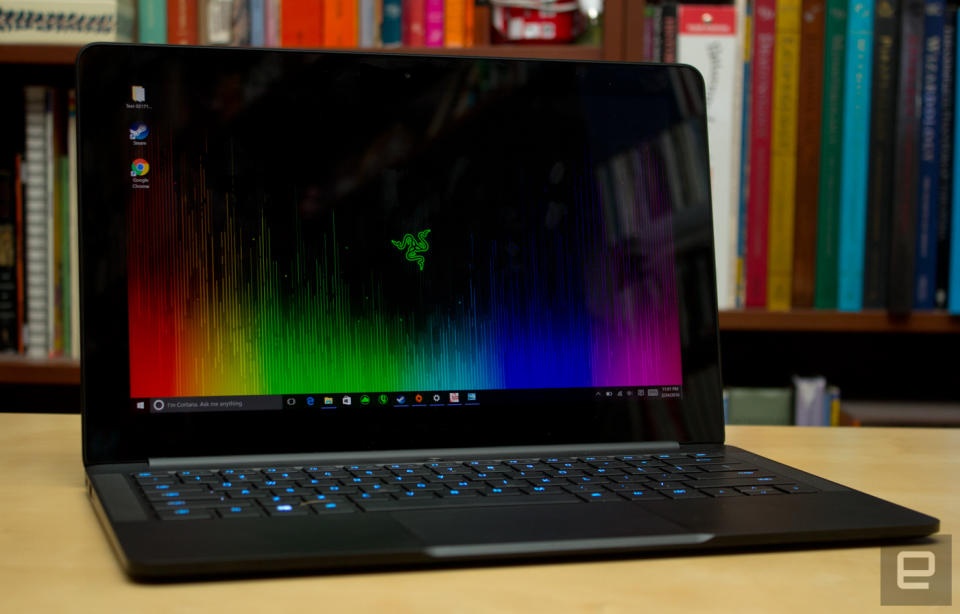
At some point, every laptop-owning PC gamer asks the question, "Can I hook a desktop graphics card up to my notebook?" Until recently, the answer was no, but times are changing. In the past year Alienware, MSI and ASUS have all announced laptops with external GPU accessories, promising a workhorse on the go and a gaming behemoth at home. Razer's take on this trend took CES by storm, running away from the electronics show with Best of CES awards for both People's Choice and Best PC. And why not? The Razer Blade Stealth is sleek with impressive specs and has a strong pedigree. Still, there's a problem: This ultraportable laptop ships without the GPU dock it needs to actually play games. Whoops.
Hardware
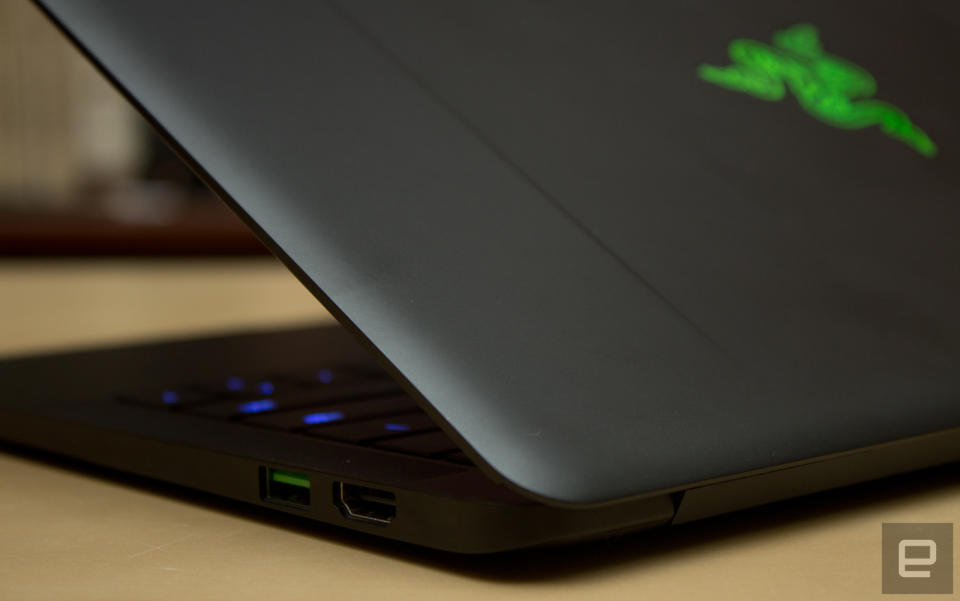
At a glance, the Razer Blade Stealth looks exactly like the company's last two gaming laptops, just smaller. It has the same matte-black aluminum chassis, the same ridged accents on its lid and the same MacBook-esque unibody design. Don't let the familiar design language fool you, though: Despite the Stealth's aggressive exterior, this is actually a lightweight productivity machine.
At 2.75 pounds and measuring barely more than half an inch thick, the Stealth is wonderfully light. More than once over the course of my testing I tossed it in my bag and forgot it was there for the lack of added weight. Razer is quick to point out that the new Blade's 0.52-inch chassis is both thinner and lighter than the 13-inch MacBook Air, but those bragging rights come with a price. The Stealth may best Apple's kit on dimensions, but it loses a bit of connectivity in the process.
The thickest point of the Stealth's frame is home to two USB 3.0 connections (one on each side), a multipurpose audio jack, an HDMI socket and a Thunderbolt 3 port. That's not bad -- two standard USB ports and a video output are nothing to complain about in an Ultrabook -- but if you're a shutterbug like me, you'll miss having a memory card reader.
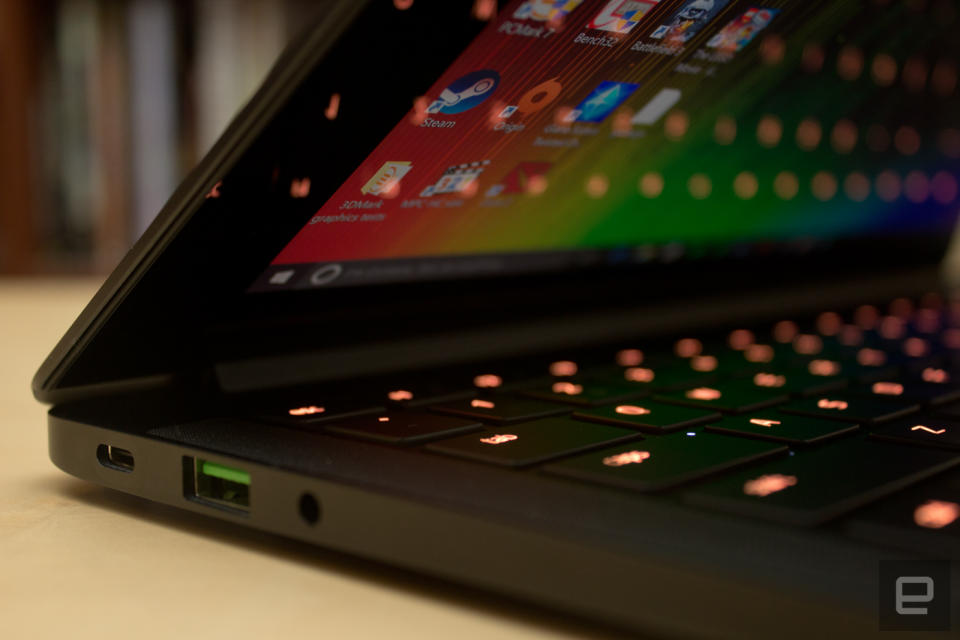
It's great to see Razer adopt Thunderbolt 3, at least: The USB-C port is not only extremely versatile (with ridiculously fast 40Gbps data-transfer speeds and the ability to pull double duty as a DisplayPort output) but is also the connector through which you'll hook up Razer's Core GPU docking station. Better still: Razer says it's not doing anything to limit the Core to just the Blade. That means any Thunderbolt 3 laptop that supports Intel's detachable graphics standard will work with the Razer Core. Until then, though, the poor Thunderbolt 3 port is little more than a place to plug in your charging adapter.
Keyboard and trackpad
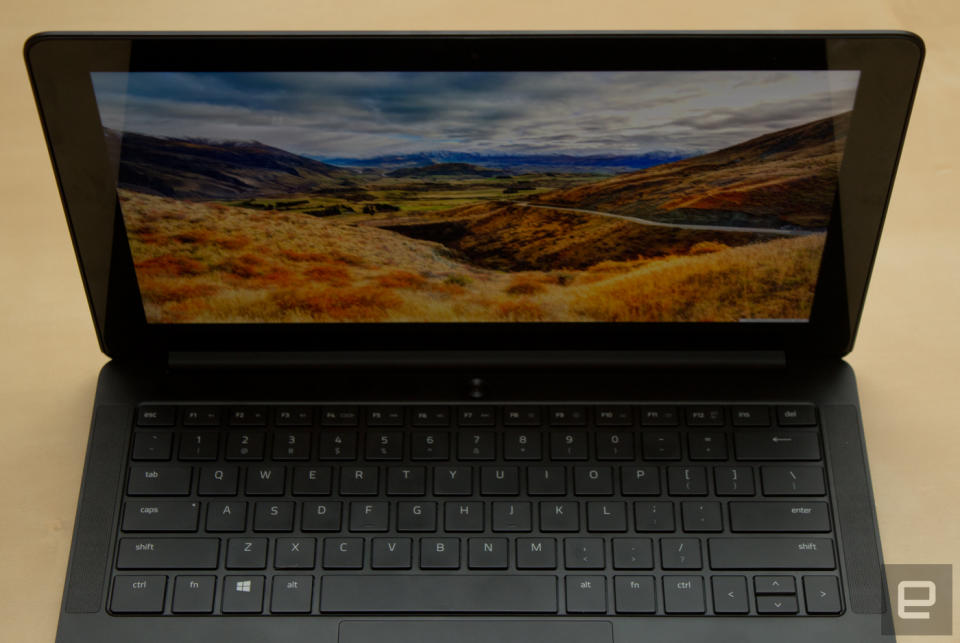
Before Razer made a name for itself with thin gaming laptops, oddball Windows tablets and modular PCs, it was primarily known for its peripherals: mice, keyboards and gamepads, all tricked out with a distinctive Razer style. They were so distinctive, in fact, that something about the Blade Stealth's keyboard looks, well, wrong. It looks too normal.
The Stealth is the first Razer Blade laptop to do away with the company's signature font -- a blocky typeface composed of mixed capital and lowercase letters. It's such a small change that I almost didn't notice it. No, I'm not overreacting: This change was likely a conscious move on Razer's part to present the Blade Stealth as a little more professional than the other machines in its lineup. One less reason for the other folks in the conference room to question your work computer. OK, maybe I am overreacting, but it's still a noteworthy change.
How's the keyboard for actual typing? It's good, but there are some compromises. The Stealth's keycaps are full size and well spaced, but they have notably less travel compared to Razer's other Blade laptops. There's more than enough give for comfortable typing, but I found the keyboard a little stiff when playing games -- an odd sensation considering Razer's deep experience with keyboards.
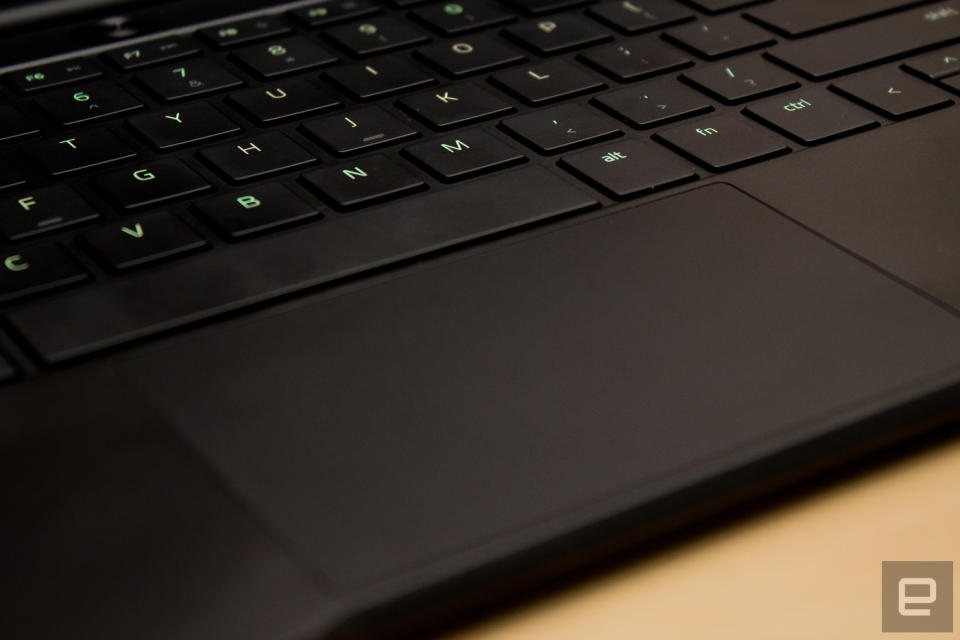
Speaking of departures from the norm, the Blade Stealth also has a buttonless trackpad -- a first for the company. I typically prefer separate, distinct mouse buttons, but in Razer's case this is an improvement: The company's previous laptops all featured excellent trackpads with somewhat mushy mouse buttons. Now all that's left is a great trackpad. That's one less negative, and it's better suited to the Stealth's Ultrabook form factor. I can't complain.
Display and sound

When it comes to laptop screens, Razer's offerings run the gamut from unremarkable to absolutely stunning. The Stealth, it turns out, falls into the latter camp. It's almost as if the 12.5-inch 3,840 x 2,160 IGZO touchscreen was created with the sole purpose of exhausting my go-to adjectives for display technology: It's gorgeous, striking, breathtaking and stunning. This panel has everything you could possibly want in a laptop display: wide viewing angles; lush, beautiful color reproduction; and deep blacks. It is, objectively, an excellent screen. It also might be overkill.
Don't get me wrong: Ultra-high-resolution displays are the way of the future, but they tend to put a dent in the portable, all-day productivity that consumers are looking for when they buy an ultraportable. The Stealth's 4K display, brilliant as it is, means you aren't going anywhere without a power adapter for very long (more on that later). It could just be that I'm getting old, but I also found the pixel density on the notebook's 12.5-inch screen a little straining. Sure, I loved having that real estate, but I found myself squinting and leaning closer to my monitor than I would have liked, even with Windows 10's scaling dialed up to 250 percent. As much as I love the display for its 100 percent Adobe RGB color space, I eventually found that a little odd, too. Here we have an ultraportable with the perfect display for editing high-resolution digital photos but no built-in card reader with which to access them. Again, weird.
By and large, overkill is the name of the game when it comes to Razer's laptops -- unless you're talking about the speakers. Those are, and always have been, merely average. Every Blade I've tested has offered clear, well-separated stereo sound with enough oomph to fill a small room. They never sound tinny, and they don't crackle or pop at loud volumes. The Stealth follows suit with a pair of nice, well-balanced speakers. They're hardly exceptional, but you'll never hear them crack or distort either.
Performance and battery life
PCMark 7 | PCMark 8 (Creative Accelerated) | 3DMark 11 | 3DMark (Sky Diver) | ATTO (top reads/writes) | |
|---|---|---|---|---|---|
Razer Blade Stealth (2.5GHz Intel Core i7-6500U, Intel HD 520) | 5,131 | 3,445 | E2,788 / P1,599 / X426 | 3,442 | 1.5 GB/s / 307 MB/s |
Toshiba Radius 12 (2.5GHz Intel Core i7-6500U, Intel HD 520) | 5,458 | 3,684 | E2,865 / P1,622 | 3,605 | 552 MB/s / 489 MB/s |
HP Spectre x2 (1.2GHz Core M7-6Y75, Intel HD 515) | 3,395 | 3,307 | E1,884 / P1,148 / X331 | 2,737 | 554 MB/s / 281 MB/s |
Microsoft Surface Pro 4 (2.4GHz Core i5-6300U, Intel HD 520) | 5,403 | 3,602 | E2,697/ P1,556/ X422 | 3,614 | 1.6 GB/s / 529 MB/s |
Lenovo Yoga 900 (2.5GHz Core i7-6500U, Intel HD 520) | 5,368 | 3,448 | E2,707 / P1,581 | 3,161 | 556 MB/s / 511 MB/s |
Microsoft Surface Book (2.4GHz Core i5-6300U, Intel HD 520) | 5,412 | 3,610 | E2,758 / P1,578 / X429 | 3,623 | 1.6 GB/s / 571 MB/s |
Microsoft Surface Book (2.6GHz Core i7-6600U, 1GB NVIDIA GeForce graphics) | 5,740 | 3,850 | E4,122 / P2,696 | 6,191 | 1.55 GB/s / 608 MB/s |
Let's be real: Without the Core GPU docking station, the Stealth isn't much of a gaming laptop. It is, however, one hell of a workhorse. Between the Intel Core i7-6500U pulsing inside and the 8GB of RAM, there was nothing in my normal workload that the machine couldn't handle. A disorganized mess of social media, video, Google Docs and music streaming tabs? Sure. A cavalcade of messaging and VoIP apps? No problem. The Razer Blade Stealth could shrug off anything I threw at it. It just couldn't do it all day long.
The Stealth survived Engadget's standard battery test (where we loop an HD video at a fixed brightness until exhaustion) for a little over five and a half hours. If we were looking at any of Razer's previous Blade laptops, I'd consider this pretty decent -- but it's disappointing for a machine billing itself as the "ultimate Ultrabook." That said, it seems to be a trade Razer made intentionally: The whitesheet the company sent over with my review unit specifically calls out the 4K-version laptop as having up to six hours of battery life, as opposed to the eight promised on the lower-resolution QHD model. Buyers should choose their configuration wisely (more on that in a moment) and pack their AC adapter: Neither build is likely to make it a full workday without a recharge.
Battery life | |
|---|---|
Razer Blade Stealth | 5:48 |
Surface Book (Core i5, integrated graphics) | 13:54 / 3:20 (tablet only) |
MacBook Air (13-inch, 2013) | 12:51 |
HP Spectre x360 | 11:34 |
Surface Book (Core i7, discrete graphics) | 11:31 / 3:02 (tablet only) |
Apple MacBook Pro with Retina display (13-inch, 2015) | 11:23 |
iPad Pro | 10:47 |
Chromebook Pixel (2015) | 10:01 |
Lenovo Yoga 900 | 9:36 |
Microsoft Surface 3 | 9:11 |
Apple MacBook (2015) | 7:47 |
Dell XPS 13 (2015) | 7:36 |
Microsoft Surface Pro 4 | 7:15 |
Microsoft Surface Pro 3 | 7:08 |
HP Spectre x2 | 6:43 |
Toshiba Radius 12 | 5:12 |
What about gaming? Without the Stealth's GPU dock, your options are limited. Integrated graphics have come a long way in the past decade, but Intel's HD 520 chipset simply won't cut it for modern PC games. Rise of the Tomb Raider, for instance, barely manages to eke out 15 frames per second on its lowest available graphics and resolution settings, while Fallout 4 won't even run for a lack of more-advanced DirectX features. Persistent users can find the occasional diamond in the rough -- Star Wars: Battlefront is surprisingly playable on low graphics settings at 720p -- but without Razer's desktop GPU accessory, the Stealth won't be able to replace your gaming rig.
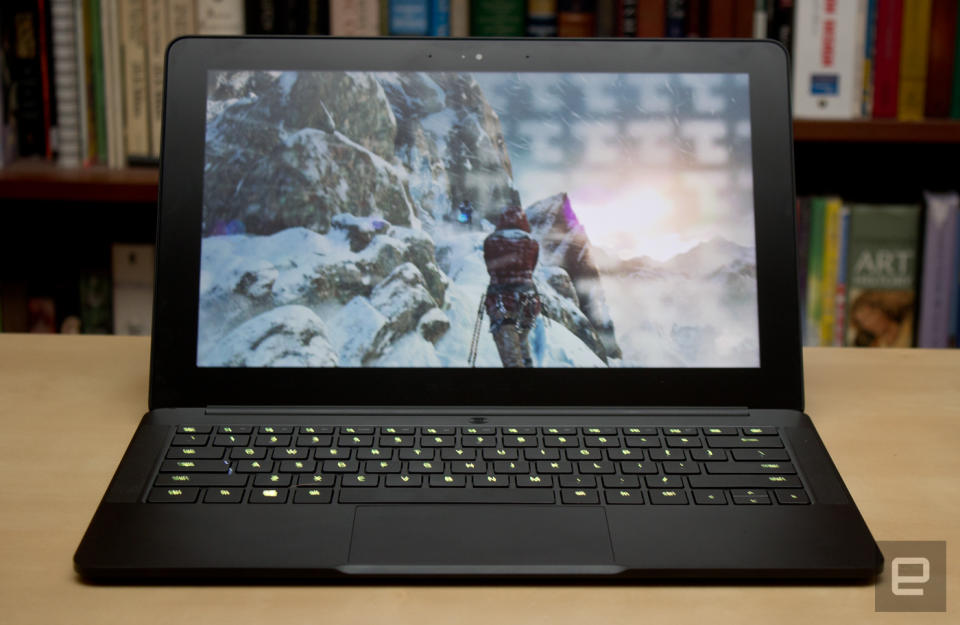
Still, that doesn't mean you can't have some fun: The machine is more than capable of handling games like Fallout: New Vegas, World of Warcraft, Portal 2 and League of Legends, as long as you dial the resolution down to 1080p. That 4K screen is beautiful, but don't expect to use it for gaming without the help of a discrete GPU.
For now the Blade Stealth is best suited to light entertainment and creative productivity, and Razer knows it -- which is probably why each machine comes with a full license for the FL Studio 12 Producer Edition. The free music production suite is a nice addition, but you know what's nicer? It's not pre-installed. Like all of Razer's laptops, the Stealth comes with virtually no bloatware.
Configuration options and the competition
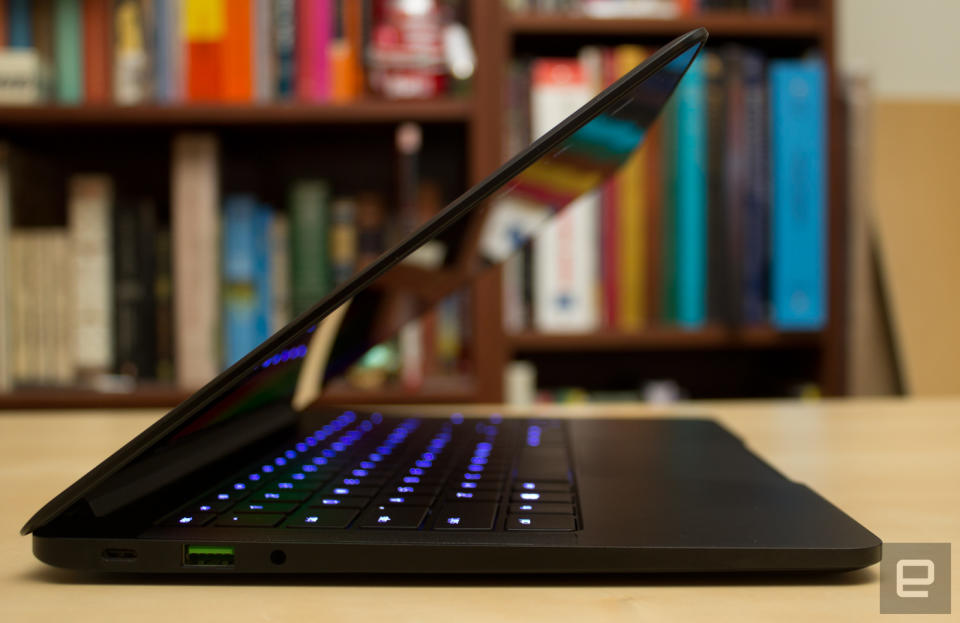
There aren't a lot of configuration options to pick from here. Each SKU features the same basic specs: a 2.5GHz Intel Core i7-6500U processor (3.1GHz with Turbo Boost), integrated Intel HD 520 graphics and 8GB of RAM. The only real differences come down to the display and storage capacity. For $999 and $1,199, you can buy a 128GB or 256GB Stealth with a QHD 2,560 x 1,440 display. This will eke out a little more battery life than our review unit, but the color reproduction will be a little less accurate, with a 70 percent Adobe RGB gamut as opposed to the 4K model's 100 percent Adobe RGB color space. If you're willing to drop $1,399 or $1,599, you can get a 4K rig with 256GB or 512GB of storage, but then you're giving up two hours of battery life. Choose wisely.
Need an ultraportable with longer battery life? There are thankfully plenty of options. Dell's XPS 13 is rated for almost two more hours than the Stealth and can be had for as low as $800 (make that $1,300 if you're dead set on having an ultra-high-resolution screen). The $1,200 Lenovo Yoga 900 is a compelling option too, scoring almost 10 hours of battery life with the same processor, RAM and storage space as the Stealth (albeit with a slightly less impressive 3,200 x 1,800 display). If you can do without Windows, check out the MacBook Air: Its 1,440 x 900 screen may be low-res by comparison, but it's hard to argue with 12 hours of runtime.
Oh, but you're looking at the Blade Stealth for ultraportable hybrid gaming and can't wait for that graphics adapter? That's different. As of this writing, there are precious few machines on the market with external desktop GPU docks. MSI's GS30 Shadow pulls off the external-graphics-dock trick but costs as much as a fully loaded Stealth and dies even faster, barely making it to two hours on battery, according to most reviews. If you must have a laptop with a GPU dock and need it now, check out Dell's Alienware 13. It still won't last long without an AC adapter, but at least it has a GeForce GTX 860M to game on when you're rocking just the laptop. If you can wait, however, sit tight: Engadget will be putting the Stealth's own Core dock through its paces once it's available. Then we'll know how the Stealth really stacks up against the competition.
Wrap-up
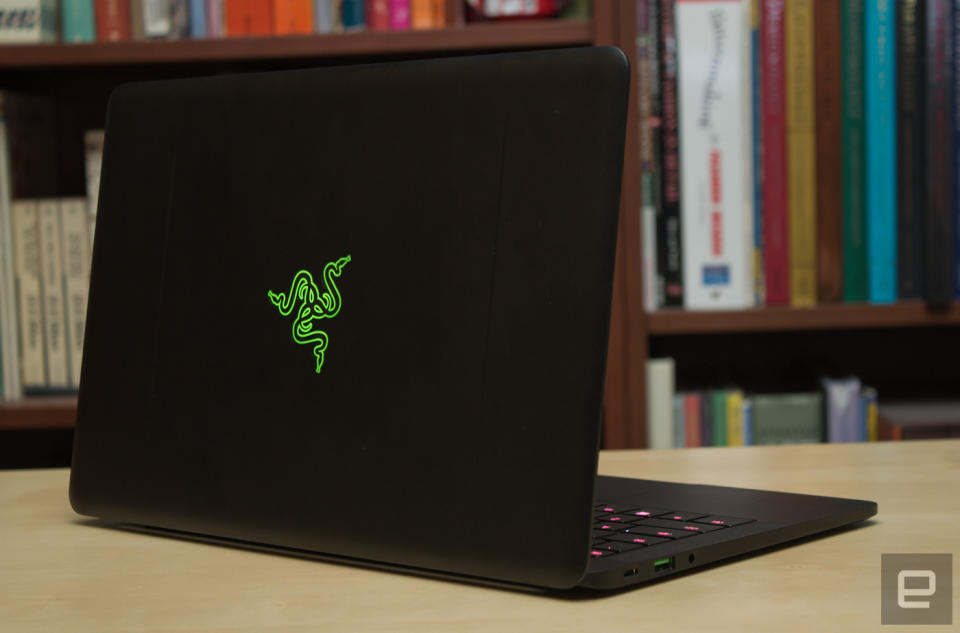
The Stealth reminds me of Razer's first gaming laptop. It's well designed and competitively priced but maybe a little too ambitious for its own good. By shooting for the moon to create the "ultimate Ultrabook," Razer kitted out the Stealth with best-in-class components that ironically keep it from competing with the longest-lasting laptops in this category. Portability and longevity are two of the key components that make an ultraportable, well, ultra portable. Six hours of battery life isn't abysmal, but the Stealth's best competition can last twice as long. That's a problem.
The laptop's saving grace lies in the same ambition that makes it a bit of a misfit in the world of Ultrabooks. When the Razer Core launches, the Stealth will have the potential to pull double duty as an ultra-powerful PC gaming desktop. If that trick works, it will more than make up for the middling battery life for some gamers. The potential is exciting, and we can't wait to see if the Stealth lives up to it.

